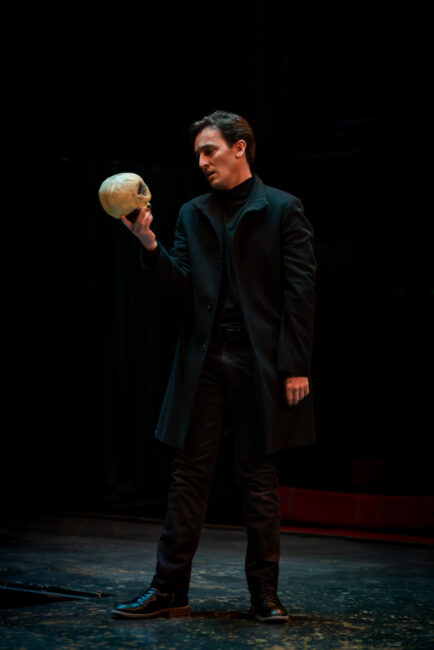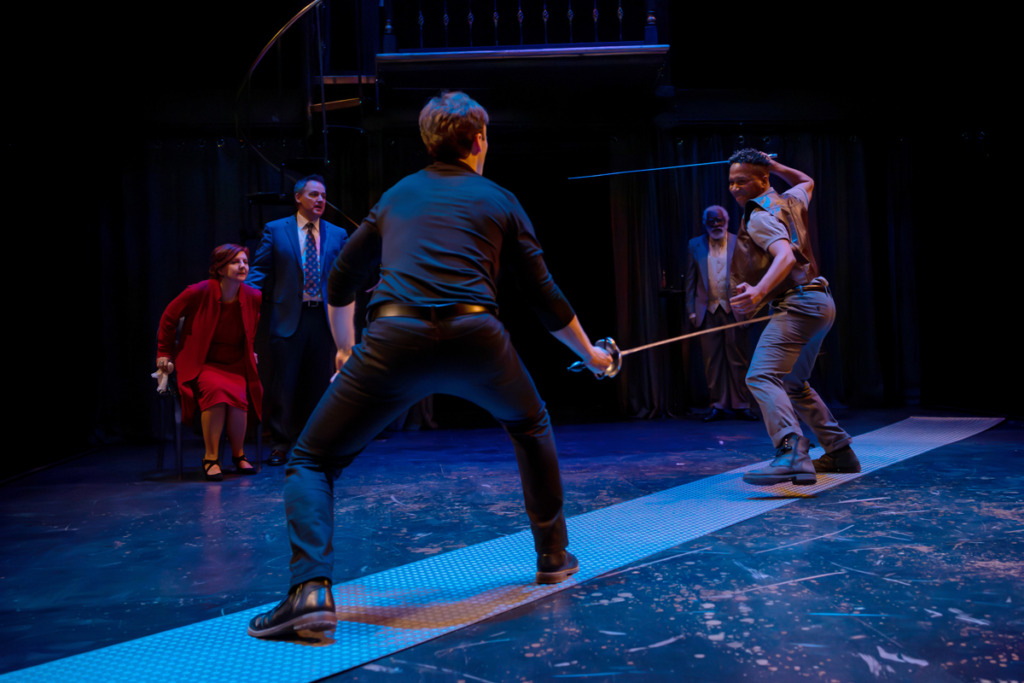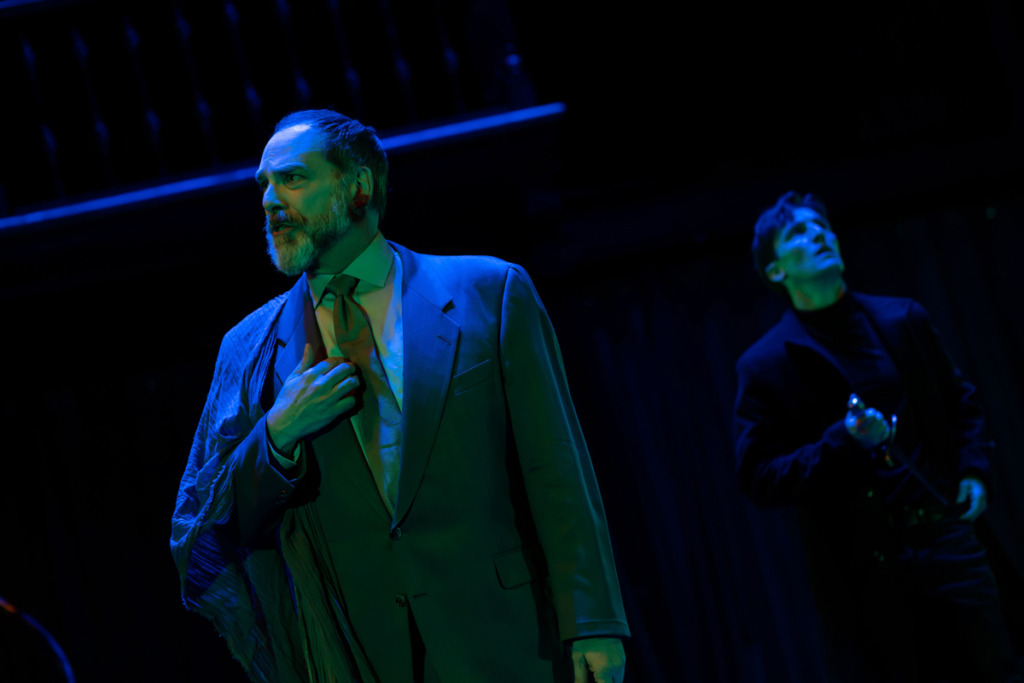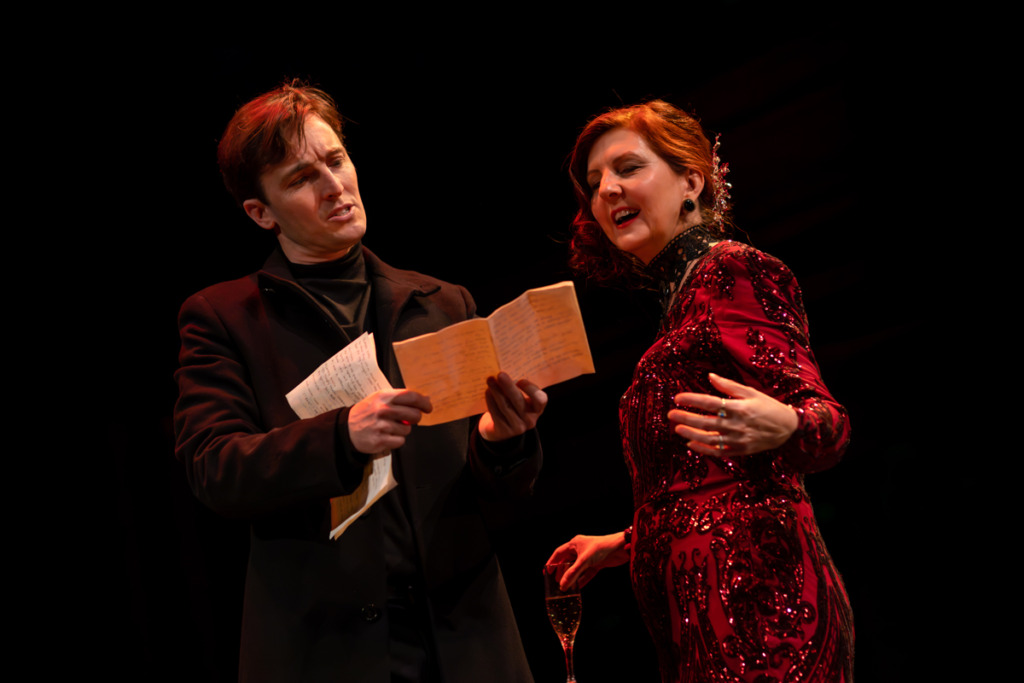When the play opens with the infamous “To be or not to be…” you start to think time is out of joint. Or maybe that you’ve just misremembered how Hamlet starts? You ever look at one of those maps of the United States where all the states have been shoved around into different spaces in the outline but it still mostly looks like the outline of the country even though everything is all discombobulated? Starting Hamlet with the electrical jolt of “…to be or not to be…” and then plunging headfirst into Claudius’ ‘greeting’ speech of the loss of King Hamlet and his new bride, the King’s recent widow, feels a tiny bit like that. Which sets the mind to wondering if things are happening in order or because you’re not just a little disoriented, that you think they might be happening slightly out of order. It’s a puzzlement indeed. Chesapeake Shakespeare Company is doing…something wondrous strange with this particular production of Hamlet, as directed by Eleanor Holdridge, and it is equal parts wondrous and strange. It also runs on the long side, despite various cuts and edits from the original text, and at times the show as a whole feels to be moving slower than is natural. For a show to have as much edited out of it as this production of Hamlet does, and still run as long as it does without any particular spectacle (other than the titular character’s frenetic physicality, which is an impressive feat all on its own) seems to be a tall order and big ask of the audience in attendance.

Aside from feeling slightly off-kilter because of the jostled start to the production, some of Director Eleanor Holdridge’s revisions to the script are curious— not curious bad or curious good necessarily, just… curious, but I suppose in being so, it makes the audience think, which is— in itself— a refreshing take on the warhorse that is Hamlet among Shakespeare’s darker dramas. (Though personally, the more times I see a production of Hamlet or Romeo & Juliet, for that matter, the more I am convinced that Shakespeare never meant for them to be tragedies but rather very dark, very twisted black comedies.)
We don’t get a copse of players… for the play-within-the-play… we get a player, listed as Player King (David Yezzi), who is cleverly pre-doubled as the Ghost of Hamlet’s Father. This may be the most oddly satisfying directorial choice that Holdridge sets down, and both the speech delivered to Hamlet from his Ghost Father and the scene wherein the player initially makes his appearance feel elongated, with a more intense focus upon these two moments than most productions generally allow for. Yezzi, who delivers a commanding presence on stage in both roles, is a force to be felt and reckoned with— more so as the Ghost King than as the Player King— and is captivating in both instances of his character deliveries.
Scenic Designer Misha Kachman and Costume Designer Gail Beach are erring on the sides of modernity and minimalism, the lens and vice of which don’t readily enhance or detract from this particular production, they’re just sort of— there. Beach does have a glorious garnet gown all glittering and glistening, which is featured on Gertrude, during the “play-within-a-play” moment, and that is astonishing to behold. The remaining costumes of the show are well designed but the overall concept of ‘mostly modern’ feels lackluster. And then it divides away from itself when Ophelia finds herself dressed in things that don’t read with the same modern/present-day vibe but aren’t so period specific or highly stylized as to truly set her apart from the others. It seems that Holdridge’s choice in both scenic elements, rather a lack thereof, and the simplistic modernity of the sartorial selection doesn’t do anything to enhance the production, which leaves the production itself feeling somewhat ordinary.
The performances across the board, with the exception of the titular character, are— for a lack of a better word— plain. It creates an imbalance in the overall perception of the production. If you’re going to have ordinary performances, however well spoke and articulated, then there should be an extraordinary concept or time and spatial setting that captivates the audience. If the approach in setting, scenery and costumes or concept is going to be basic, minimalistic, or true-to-text (from a framework or lens-approach) then the performances have to be an exemplary and extraordinary level of storytelling.

Where Holdridge does succeed with this production is in her casting of the title role and with the darker and subtler nuances of humor that she hones in on throughout the production. There are a lot of one-line responses, particularly from the Polonius character, which land heavily loaded with a wicked sense of dark humor and the audience thoroughly enjoys these moments. The way Holdridge frames up the play-within-a-play scene— by having Hamlet force both Gertrude and Claudius up into the play alongside the Player King, is rather an impressive choice because it drives home the Hamlet’s mouse-trap intentions in this moment. Holdridge also plays up the intensely meaningful relationship between Horatio (Brendan Edward Kennedy) and Hamlet, giving it a heavy bromance feel.
Lighting Designer Katie McCreary, working alongside Sound Designer Scott Killian, does a resplendent job of adding atmosphere to the performance. The ghastly greenlight and glowing fog that trails the ghost king, accompanied by the electric zap sounds and blue light, which seem to strike whenever Hamlet is shocked by his asides, add an almost dreamlike notion to the overall production experience.
Hands down the most impressive feat of the show (aside from Hamlet doing parkour on the stage to show off how crazy-fit he is) is Kristen Pilgrim’s fight choreography. When Hamlet and Laertes (JC Payne, whose rage-funnel-fury-cone almost melts the stage when he returns in the second act) get to the fencing scene near the end of the production, it is wild. There is a virulent authenticity to the way their weapons clang, the way their bodies move, and the overall choreographed dance that these two actors portray with the seasoned skills that Pilgrim lays down over the performance. (Another feather in the cap to Lighting Designer Katie McCreary here because the effect used when they are actively swinging their foils about is absolutely amazing.)

You do get quirky giddiness from Rosencrantz (Dagan Brown) and Guildenstern (Briana Manente) when they are called to action. And you get a regal sense of pride from Dawn Thomas Reidy, playing Fortinbras, who although she only arrives near the end of the show, you feel as if her character is as important as others who have been featured throughout. Gregory Burgess lends a singsong air to the Gravedigger character (Misha Kachman’s set does include a hole in the stage into which Burgess half-stands and whips out poor Yorick’s skull) and Reidy is again featured here as a nameless, secondary Gravedigger.
Vince Eisenson, as the titular role of Hamlet is remarkable and astonishing. There is something unspeakably wise about his approach to the character and yet it is tempered with that roguish youthful exuberance that makes him a believably-aged character. Eisenson is throwing himself all over the stage in ways that make you marvel at just how active he is. All of the madness that Eisenson brings to Hamlet feels intentionally put-on, which serves its purpose of proving that Hamlet is the boy-genius hellbent on revenge rather than driven to lunacy by the events of the plot. When in confidence with Horatio (Brendan Edward Kennedy) he is lucid, almost felicitous of spirit, and the ability to switch in and out of sanity at the blink of an eye is exquisite. You get a full gamut of emotions run by Eisenson’s Hamlet, particularly when he’s attempting to put Gertrude (Lesley Malin) back into her place. To Malin’s credit, her speeches are spoken perfectly, as any well-practiced Shakespearean actor, but there is no guiding concept that directs this Gertrude to her place in the play.
Marcus Kyd, as Claudius, has the restricted potential to be this domineering political overlord. You can feel it just burbling beneath the surface, particularly when he’s barking commands to Rosencrantz and Guildenstern about how Hamlet is to be handled. And you get this truly terrifying moment from Kyd when he loses his mind during the “play-within-a-play” momenta and almost hauls off and backhands Hamlet, but for the most part it feels as if his character keeps smacking up against an invisible emotional ceiling that confines what the character could be. The crisply pressed suits again allude to the fact that his character could have more political leanings in a modern day vein, but with the minimalistic guiding thread of the production’s overall aesthetic and framework, this is never fully brought to fruition. Like Malin, he delivers textbook Shakespeare, as one would expect from any CSC performance; much like DeJeanette Horne (who plays Polonius) there are several quippy dark one-lined responses that get the audience chuckling in places that are usually void of laughter.

This approach to the production truly makes it a story focused solely on Eisenson’s Hamlet and if there were a less-impressive actor in the role, the show might not stand as well as it does. When Eisenson engages the audience in soliloquy, particularly the “words, words, words” moment which turns into dialogue with another character, he’s physically out among the house, fully embracing the audience almost as if they were a part of his psyche. There is an incandescence about Eisenson that he shares with the audience as Hamlet; occasionally he shares it with David Yezzi (both Ghost King Hamlet and Player King), and it has the audience ensorcelled, completely hypnotized by his authentic charisma and genuine charm.
It’s a good first exposure if you’ve never seen Hamlet, Chesapeake Shakespeare Company will ensure that you get a bit more than the gist. But if you’ve ever seen Hamlet or read Hamlet or seen other CSC shows, this one may leave you craving something more in everything except the titular character, who is superb. Lots of performances left you wanting more, lots of design components left you wanting more, it feels like a back-to-basics-approach that somewhat missed the mark from a design standpoint, but for Hamlet and his father/the player king alone, the show is worth seeing.
Running Time: Approximately 3 hours and 15 minutes with one intermission
Hamlet plays through May 21st 2023 with Chesapeake Shakespeare Company— 7 S. Calvert Street in Baltimore, MD. Tickets are available by calling the box office at 410-244-8570 or purchasing them in advance online.
